7,500t empty, 1,920 passengers, 200m in diameter
Earth date: 10:17 p.m. Tuesday January 16, 2142
Venusian date: 7:00 a.m. Croday 45 advanae 61
Location: 75,000km above Venus

7:00 am, An alarm rings, the time to disconnect it, open your eyes to a small minimalist white bedroom with fine and light furniture. The memories come back to you, the Bifröst, you are on your last day of travel to Venus. This story began after an internship in the moon mining colonies, when you were offered a job at Babakine Station. It is a medium-sized Venusian colony, about 20,000 inhabitants, named in honor of an engineer who marked space exploration and Venus in particular. For now, the contract is for 15 months on site with the possibility of returning to Earth at the end of this first contract. It will also be an opportunity for you to discover a new environment and to change lunar bunkers as well as diving trips. Thus, you do not rule out the possibility of extending the contract on the spot because if nearly half a million people have settled permanently on this planet, life must be comfortable there.

Discovery of the Bifröst
Five months ago, you started by once again reaching the Moon thanks to the vessels which regularly shuttle from Earth. But instead of taking a lander to the surface, you’ve joined Bifröst in high lunar hold orbit. The Bifröst, named after the bridge between the worlds of Nordic legends, is one of the interplanetary transport vessels as it has circulated at every firing window since the start of space colonization. Between two firing windows, these huge ships are often placed in very elliptical holding orbits around the planets. This causes them with a low acceleration to reach liberation speed and set themselves on an interplanetary trajectory. On Earth, such an orbit would involve numerous passes through van Allen’s radiation belts that would ultimately affect the electronics and the health of maintenance technicians. The Bifröst is therefore stored around the Moon or it can easily be reached thanks to the Earth <=> Moon transport network and can be refueled with propellant produced on site.
The first thing that impressed you when you saw the Bifrost was its huge solar panel, 200m in diameter, which plunges the rest of the ship into darkness. Indeed, apart from the phases of propulsion, the latter is constantly oriented towards the sun. This panel hides two huge wheels made up of an interweaving of modules capable of accommodating a total of nearly 2,000 passengers. With a hundred meter radius and complete a revolution in 40s, they create an artificial gravity similar to that of Mars (1/3 of the Earth’s gravity). Even low, this gravity is a relief during this long trip because it allows you to keep the majority of everyday reflexes (walking, putting an object on a table, running water, feeling the tastes). The center of these wheels consists of a thick central tube to which the starships that you used to join the Bifröst around the Moon and which you will use today to join Venus remain moored.
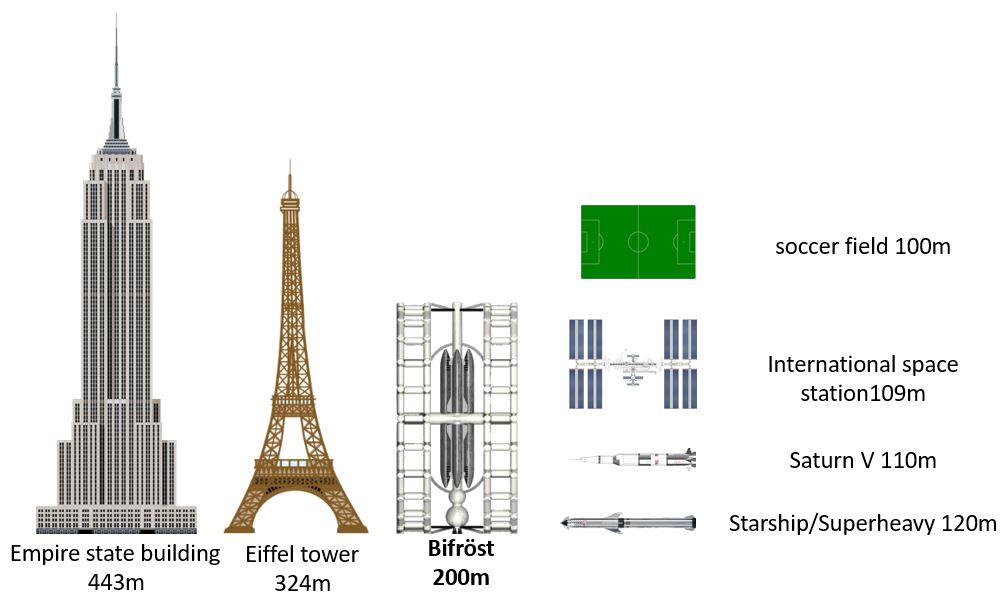
Interplanetary travel
Once all the passengers had boarded, the wheels of the Bifröst must have stopped, and cut the artificial gravity that prevailed there. The goal is to avoid the gyroscopic effect which decreases the maneuverability of the vessel. Thanks to the control motors on the ship, it left its pointing towards the sun to get on its acceleration path. At this point, the cryogenic motor located at the rear imparts a weak acceleration to the ship just enough to leave the lunar attraction and plunge towards Earth. To avoid damaging the structure, during the pushing phase, reinforcements fix certain points of the wheels to the central tube. After two days of travel, as the coarse Earth saw eye through the portholes, the wheels were again stopped and all passengers were asked to assemble in the middle of the food stores. Indeed, these warehouses are shielded against radiation and serve as shelter in the event of a solar storm or, as this time, for the passage of the Van Allen radiation belts. After a few hours you were able to go out and admire the nearby Earth one last time. As the spacecraft flies over the planet a few hundred miles away, the cryogenic engines reignite briefly, imparting sufficient acceleration to exceed release velocity and head towards Venus. After a new phase of confinement in the food stores to iron Van Allen’s belts, the wheels spring back into action and interplanetary flight has begun.
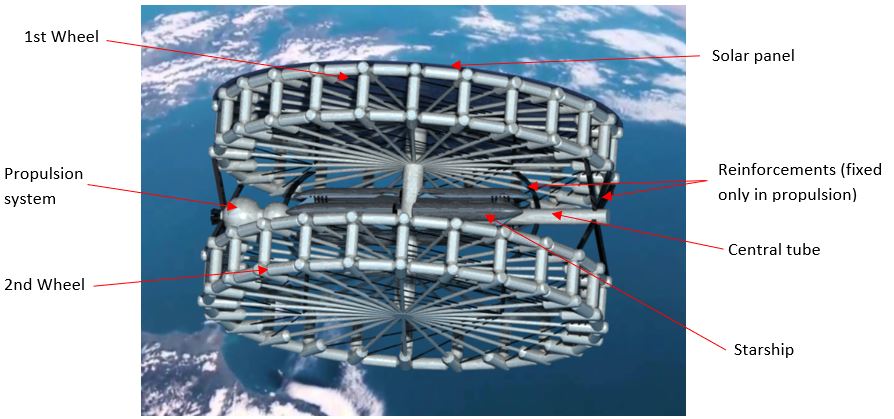
You remember the deep feeling of isolation you felt on this trip. Indeed, with the exception of the first and last week, the Bifröst was literally alone in the midst of nothingness. The only thing you observed in the portholes were stars which (due to the spinning of the wheel) paraded against a black background of unfathomable depth. The main point of reference, the sun, is perpetually hidden by the panel. The Earth, which initially looked like a magnificent blue jewel floating in the dark of space, had within a week become a mere dot barely brighter than the other stars. Venus began by hiding next to the sun, then appeared as a small shining shard. Only the sharpest eyes could make out the thin crescent of light it formed. Over time, it grew brighter, quickly becoming the brightest star in the sky. It also moved away from the sun until it formed a 90 ° angle with it, and the crescent became a shining hemisphere from which you can make out the clouds for a few days.
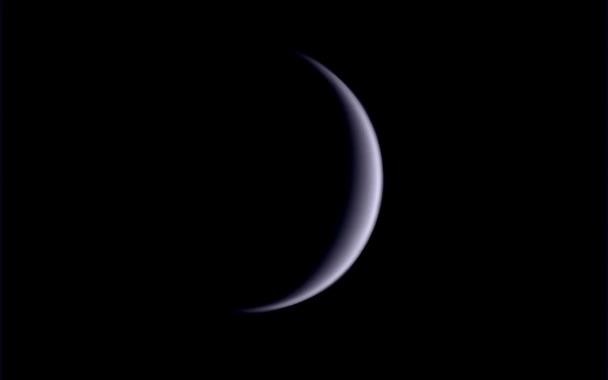
This visual isolation was supplemented by an isolation of communications due to the astronomical distances traveled which become not negligible in the face of the speed of light. A week after leaving Earth, the response time to a message reached ten seconds, making audio or videoconferencing conversations impossible. For three to five, you communicated with the outside of the ship only by email with a response time of several minutes. The only exception was the few days you passed the Pegasus, the Bifröst twin who was making the Venus-Earth trip with some colony wishing to return to Earth. For the past few days, you have been communicating almost directly with your future colleagues on Venus. However, for your family back on Earth, the minimum response time is 7 minutes. During your mission, this delay will increase and will reach a maximum of 30 minutes in ten months. At that time, the sun will be between Earth and Venus and will cut off direct communications. Only essential messages can be sent by being relayed by the Martian colonies or specific relays at the LaGrange point. After a few days of radio blackout, direct communications will resume and the delay will decrease to less than ten minutes before the next firing window in 15 months.
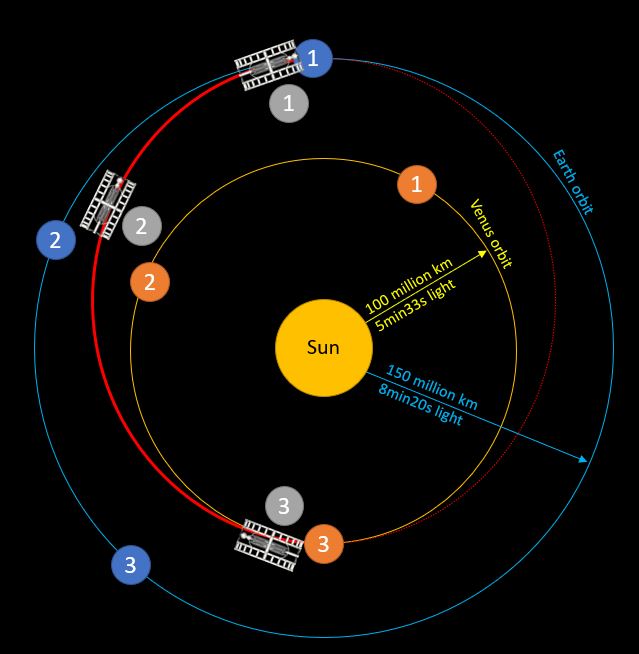
7:05 am: the second alarm ringing pushes you to get up. By opening the window shutter you admire in the half-light the usual spectacle of the parade of the modules of the first wheel that you admire from your room located in the second. However, during the rotation, an unusual yellowish light begins to illuminate the vessel. Sticking to the window, you see a blinding glare at the bottom left. As you knew, Venus as seen from orbit is brighter than the sun as seen from earth. This is due to clouds which very effectively reflect near sunlight. By the time your eyes get used to it, Venus appears huge, the size of a balloon held at arm’s length. Only a hemisphere facing the sun is visible. In an infinite number of variations of yellow, it reveals fluffy clouds composed of tiered structures much more impressive than the photos you have seen. Looking further down, you can see the boundary between the illuminated side and the night side of the planet. This boundary is unclear as the tallest clouds are still directly lit by the sun and still glow with a powerful yellow glow. Clouds below are illuminated only by reflected light from other clouds and appear red. This red continues in the unlit phase before gradually disappearing to give way to black. By placing your hand in front of the illuminated phase of the planet, your eyes become accustomed to the darkness again and allow you to distinguish the unlit face only by the absence of a star in this sector. This spectacle lasts about ten seconds until Venus disappears at the bottom right of your window and about twenty seconds later, it reappears on the other side, like a day-night cycle of around forty seconds.
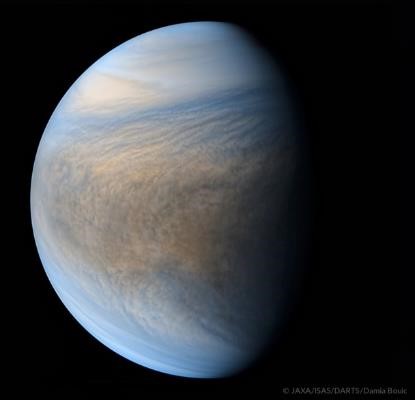
Interior design
After admiring this spectacle several times, you get up in your strangely empty apartment. With a kitchen and a bathroom, this approximately 15m² apartment looks like a student studio and allows you to have a space of your own in the huge beehive that is the Bifröst. It has always seemed quite impersonal to you because it is used by a new person on each trip, but then on top of that it is downright empty. Indeed, these last days you must have packed the few personal belongings that you took in a suitcase that you installed in the Starship that will take you to Venus.
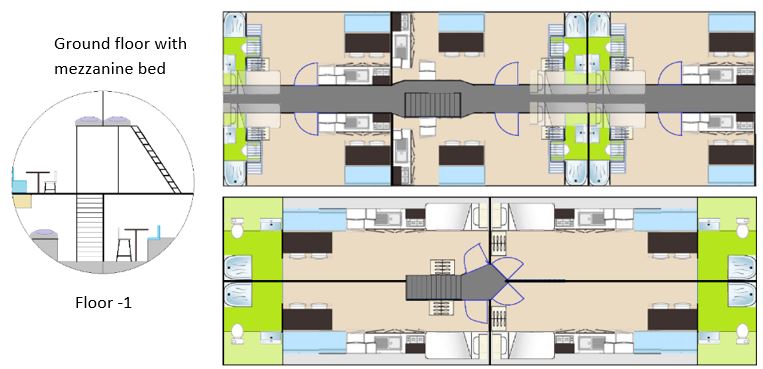
A good breakfast, a trip to the bathroom and you put on your flight suit. It is designed to protect you in the event of depressurization of the starship during atmospheric reentry. Much more comfortable than its equivalents from the beginning of the space conquest, it is specially adapted to Venus. Compared to your old moon suits, you immediately spotted the outer layer of Teflon that protects against clouds of acid. In addition, a small bag includes a balloon to deploy in the event of an evacuation if the starship fails to land. Once inflated with helium, this balloon lets you float like a hot air balloon and wait for help. Once dressed, all you have to do is put away the dishes and fold the sheets when you leave your room. As you descend to the surface, the Bifröst will enter a waiting orbit where it will be visited by a maintenance and housekeeping crew who will prepare it for its next voyage. Indeed, in 15 months, at the next firing window, workers ending their mission or Venusian colonists wanting to visit Earth will take it for a Venus-Earth trip while the PEGASUS will do the opposite route.
In the corridor you see that the majority of your neighbors are doing the same and you leave the housing module to join them in the Agora module. These modules regularly distributed on the wheels bring together all the common living spaces for about thirty people. They are the heart of the “neighborhoods” made up of three housing units of around ten apartments like yours. In the wheel, between the districts, there are “special common modules” (SCM). Unlike neighborhood modules which are similar in function and therefore shape, SCMs are often unique in Bifröst. They house the infrastructure that is not necessary for a district of 30 people but essential for the city of 2000 inhabitants that is the vessel. These modules can be services such as hospitals, administrative offices, technical workshops, or central kitchens, but others are intended for leisure, such as certain sports facilities, performance halls or shops.
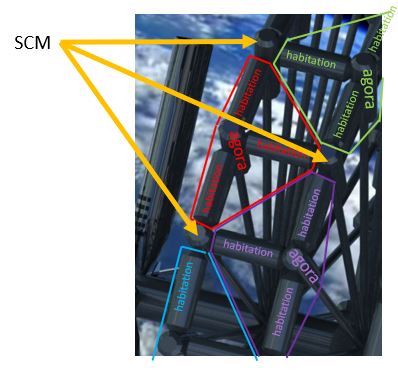
In addition to the wheels, much of the center tube is open to everyone, such as 0G gyms, storage spaces and starship moorings. More sensitive parts such as power plants, life support systems or propulsion components are reserved for qualified personnel. In fact, only the captain and a few engineer officers who supervise the maintenance of the vessel between two windows of fire are full-time crew members of the Bifröst. The rest of the positions, from starship pilots to maintenance personnel, are held only during interplanetary flights by passengers according to their skill set.
When you enter the Agora it is hectic, some are looking at their e-mail on the free computers, others are helping themselves to a coffee but the majority are chatting. To avoid the crowd, each district takes turns embarking on the starship. As the last latecomers arrive and the few goodbye speeches finish, it’s time for yours. You were among the first to board the elevator from the wheel to the center tube. By elevator, we mean in fact a simple platform which slides in the radius of 100m of length of which you barely make out the end above you. As the elevator goes up, you feel the artificial gravity diminish until it becomes almost imperceptible as you come to the end of the climb. Where some prefer to hold for a few seconds in the elevator, you take advantage of the deceleration to throw yourself forward, do a pirouette and land on your feet in the center tube. You need to suppress a feeling of dizziness until your sense of balance realizes that the central tube is not rotating.
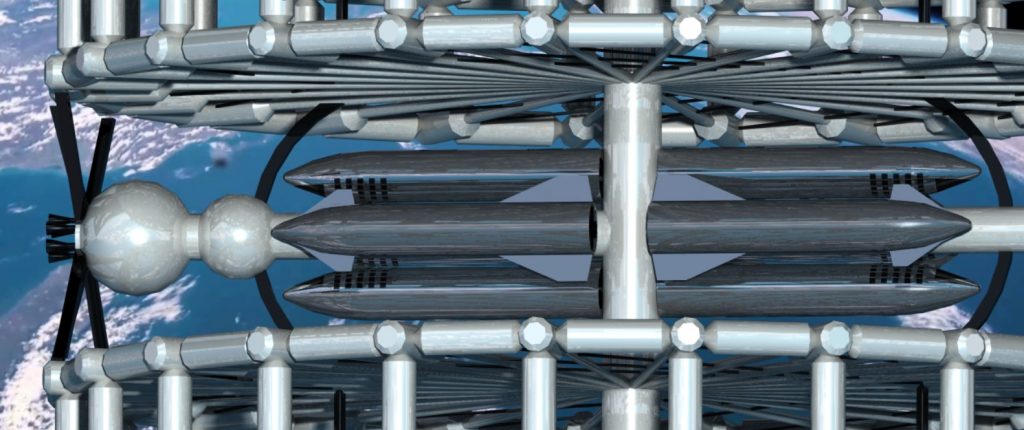
You then move weightlessly through the now nearly empty food stocks, rejoicing that you didn’t have to take shelter there because of a solar storm. You finally enter the departure lounge where you say goodbye one last time to the residents of your neighborhood who are leaving for settlements other than you. It is now time to leave the Bifröst which was your home for 5 months and passed the starship airlock which will take you to Venus.